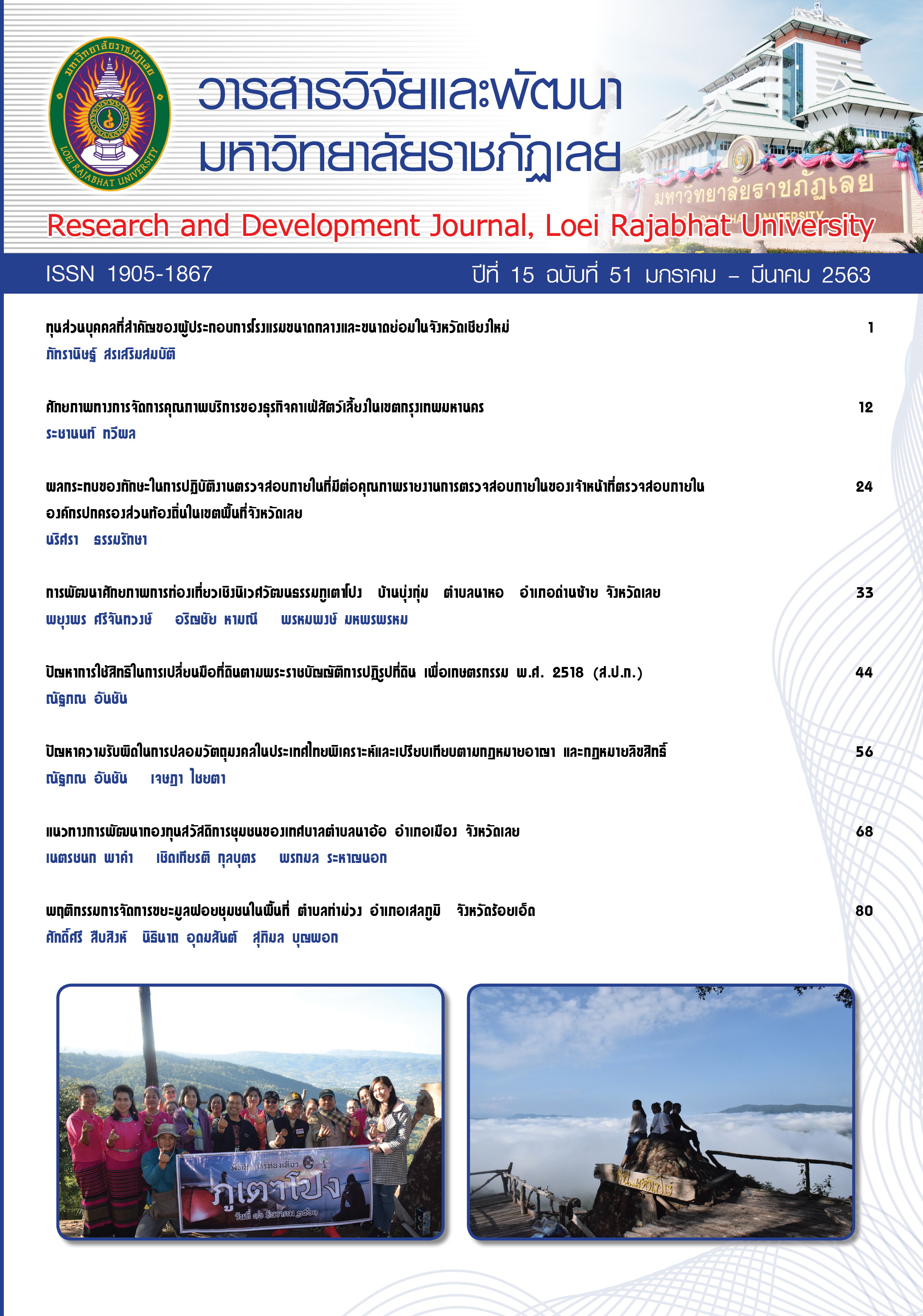The Problem of Liability for Fake Sacred Objects in Thailand Scrutinize and Compare According to Criminal Law and Copyright Law
Keywords:
counterfeiting of sacred objects, liability for criminal law, protection of intellectual propertyAbstract
Research on the problems of liability for counterfeiting of sacred objects in Thailand is aimed on analysis and comparison under patent law, copyright law and criminal law. The objective is to study the source of the problem in registration of the rights according to patent law, copyright law, regulation, theory and legal measures relating to liability for counterfeiting of sacred objects in Buddhism under the criminal code, Section 206, Section 207 and Section 208. This research study to the comparison of criminal law and copyright law related the rights of sacred objects under the civil and commercial code, that is the principle of property taking the results of the study to be a guideline for amendment of the criminal law by applying those who make sacred objects may have to register their rights in order to be entitled to legal protection. In addition, this research shall study the legal penalties for a person who counterfeits the sacred objects.
This research is a qualitative research studied from patent law, copyright law, criminal code and civil and commercial code including textbooks, books, academic articles of law, interviews with the experts and the people involved. This paper reviews the methodlogy of a method-comparison. From this study, it is found that there is no clear law applying to the case of counterfeiting of sacred objects. According to criminal code, Section 206, Section 207 and Section 208 provide that whoever does by any means to an object or a place held sacred in any religion of any group of people in a manner likely to insult such religion, or whoever cause a disturbance at any assembly of persons who believe in religion during a lawful holding of a conference, religious worship or any religious ceremony, or whoever wrongfully dresses or makes use of any symbol which represents for a Buddhist priest or novice, an ascetic or a clergyman of any religion in order to cause another person to believe that he or she is such person, these shall be liable to imprisonment or a fine. When we have considered these sections, it shall be seen that there is no penalty for direct liability in case of counterfeiting of sacred objects.
According to suggestions, it should amend criminal code in the provisions of Section 206 that whoever does by any means to an object or a place held sacred in any religion of any group of people in a manner likely to insult such religion shall be liable to imprisonment from one year to seven years or a fine of twenty thousand baht to one hundred and forty thousand baht, or both. This amendment is the benefit and importance of Buddhism, the approximately 95% of the Thai people from 69.04 million are Buddhists. Therefore, it should be and amended so that people who counterfeit or imitate sacred objects are punished according to the law in order to preserve Buddhism for a long time.
References
กัลย์ กัลยาณมิตร. (2561, กรกฎาคม). มหาวิทยาลัยแม่โจ้. เข้าถึงได้จาก https://www.erp.mju.ac.th/acticleDetail.aspx?qid=66
ณัฐพล อยู่รุ่งเรืองศักดิ์. (2555). ประวัติศาสตร์ผ่านพระเครื่องนครปฐม (วิทยานิพนธ์ของบัณฑิตวิทยาลัย). มหาวิทยาลัยศิลปากร, กรุงเทพฯ.
เดชา กิตติวิทยานันท์. (2552). การป้องกันการละเมิดสิทธิในทรัพย์สินทางปัญญาที่เผยแพร่ทางอินเทอร์เน็ต, สืบค้นจาก https://www.decha.com/main/showTopic.php?id=2123
ธำรงศักดิ์ อายุวัฒนะ, นาย. ประวัติกรมการศาสนา และการพระศาสนาในประเทศไทย. (2516). ที่ระลึกในงานพระกฐินพระราชทาน, กรุงเทพฯ: โรงพิมพ์การศาสนา
พระเทพเวที (ประยุทธ์ ปยุตฺ โต). (2534). สถานการณ์พุทธศาสนาพลิกหายนะเป็นพัฒนา. กรุงเทพฯ: โรงพิมพ์มหาจุฬาลงกรณราชวิทยาลัย.
พระบาทสมเด็จพระจุลจอมเกล้าเจ้าอยู่หัว. (2505). พระราชปรารภเรื่องพระพุทธชินราช. จดหมายเหตุกรุงสยาม, หน้า 48-50.
พระมหาเชิด เจริญรัมย์. (2541). พระเครื่องกับสังคมไทย: ศึกษาเฉพาะกรณีทัศนะของนักวิชาการพุทธศาสนาในสถาบันอุดมศึกษา. กรุงเทพฯ: มหาวิทยาลัยมหิดล.
ราชบัณฑิตยสถาน. (2556). พจนานุกรม ฉบับราชบัณฑิตยสถาน พ.ศ. 2554 เฉลิมพระเกียรติพระบาทสมเด็จพระเจ้าอยู่หัว. กรุงเทพฯ: ราชบัณฑิตยสถาน.
ราชบัณฑิตยสถาน. (2554). พจนานุกรม ฉบับราชบัณฑิตยสถาน เฉลิมพระเกียรติพระบาทสมเด็จพระเจ้าอยู่หัว. กรุงเทพฯ: ราชบัณฑิตยสถาน.
ราชกิจจานุเบกษา. (2537). ในพระราชบัญญัติลิขสิทธิ์ พ.ศ. 2537 วันที่ 21 ธันวาคม พ.ศ. 2537 เล่ม 11 ตอนที่ 59 ก (หน้า 286-288). กรุงเทพฯ: คณะรัฐมนตรีและราชกิจจานุเบกษา.
ศศิวิมล สิทธิโชค. (2557). ปัญหาในการควบคุมการจัดสร้างและการเช่าบูชาวัตถุมงคล ตามกฎหมายที่เกี่ยวกับพุทธศาสนาของประเทศไทย (วิทยานิพนธ์นิติศาสตร์มหาบัณฑิต). มหาวิทยาลัยธุรกิจบัณฑิต, กรุงเทพฯ.
ศูนย์ทรัพย์สินทางปัญญาและบ่มเพาะวิสาหกิจ. (2553). มหาวิทยาลัยธรรมศาสตร์ E-mail: tu_tubi @hotmail.com, tu.tuipi@gmail.com
สุริยัน จันทรา, (2547). ลิขสิทธิ์ องค์จตุคามรามเทพยอดเสาหลักเมือง ผ้ายันต์พระโพธิสัตว์พังพระกาฬและผ้ายันต์ อ.979/2547 (ศาลทรัพย์สินทางปัญญาและการค้าระหว่างประเทศกลาง 29 พฤษภาคม 2547).
แสง จันทร์งาม. (2534). ศาสนา ปรัชญาศาสนา (พิมพ์ครั้งที่ 2). กรุงเทพฯ: ไทยวัฒนาพานิช
AP Cowiv. (1989). Oxford Advanced Learner s Dictionary of Current English. Fourth Edition. London: Oxford University.
Paul Procter. (1978). Longman Dictionary of Contemporary English. London: Longman Group.
Downloads
Published
How to Cite
Issue
Section
License
ข้อความที่ปรากฎในวารสารฉบับนี้เป็นความคิดเห็นของผู้เขียนแต่ละท่าน สถาบันวิจัยและพัฒนา มหาวิทยาลัยราชภัฏเลย และกองบรรณาธิการ ไม่จำเป็นต้องเห็นด้วยและไม่มีส่วนรับผิดชอบใดๆ
สถาบันวิจัยและพัฒนา มหาวิทยาลัยราชภัฏเลย ขอให้ผู้อ่านอ้างอิงในกรณีที่ท่านคัดลอกเนื้อหาบทความในวารสารฉบับนี้






